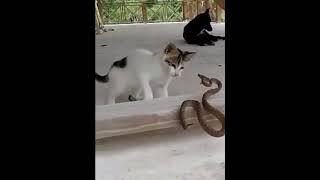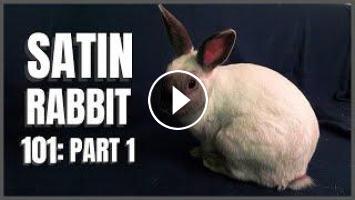The Satin Rabbit actually has an origin story that is quite unique. It is a breed that can trace its roots to Havana.
At first, a certain breeder from Indiana named Walter Huey was trying to find different ways to improve the Havana rabbits he already had with him. What happened was that he was able to breed a different kind of Havana rabbit in a certain litter. The rabbit had a unique appearance, which prompted Huey to send some of those rabbits for testing at Harvard University.
Geneticists at Harvard found out that the rabbit that Walter Huey had was a result of a genetic mutation. It appeared that a recessive gene in the Havana Rabbit was the cause of the entirely different shine and texture of this rabbit’s coat. In that sense, they still regarded this rabbit as a simple mutation of the Havana Rabbit breed.
But when Huey introduced the unique specimen to the rabbit world in comparison to the Havana, experts and other breeders were unable to accept that it was just an ordinary Havana with a mutation. As such, the National Havana Club recognized the rabbit as a variety of Havana called Satin Havana. It then received a sponsorship from the American Association of Havana Breeders for breeders to produce new colors of this unique and new rabbit breed.
Physical Description.
The Satin Rabbit is a medium to large-sized breed that can be quite heavy even though it carries a compact and commercial body type. This breed can weigh somewhere between 8.5 to 11 pounds as a rabbit in its full size. However, these rabbits have a European variety that is smaller and is somewhere close to 8 pounds at maximum size due to different breeding techniques and environmental considerations involved in breeding that variety of Satin Rabbits.
As mentioned, the Satin Rabbit carries a commercial type body that is compact and quite rounded in the places where it is expected to be round. It looks fat and plump because of how round yet smooth its hindquarters are. The back of this rabbit curves quite well and is round and high enough that it can exceed the height of its erected ears when it is sitting flat on the ground. While the Satin Rabbit may be known for being round, it is slightly narrower near its shoulders to give it a shape that is quite reminiscent of a mandolin.
The Satin Rabbit has a head shaped like a wedge but still broad. The ears tend to be erect and are actually considered long and may be as long or even longer than the length of the Satin Rabbit’s head. Meanwhile, regardless of the color of the rabbit, it usually has eyes that are reddish-brown in terms of color.
Its coat is where the Satin Rabbit sets itself apart from all of the other breeds of rabbits. It may have a similar overall appearance and body structure to the Havana, where it was originally bred from, but it has since grown and developed into its own unique breed and has a coat that is very different from that of the usual Havana. The one thing that makes it more unique than most other domesticated rabbits is that its coat has a satin sheen that gives it its name. When you try to stroke its coat, you will notice how smoothly your hand will glide through it like satin silk sheets. It also has that shiny kind of appearance.
The reason why the Satin Rabbit has a coat like this is that the recessive genes of the Havana make its individual hair follicles smaller in diameter compared to most other rabbits. The hairs also have air pockets that catch light that shines on the rabbit to give the Satin Rabbit its unique sheen.
But, even though the Satin Rabbit looks like it needs a lot of grooming because of its unique-looking shiny hair, it actually does not need a lot of maintenance. Other than the usual grooming requirements of any normally domesticated rabbit breeds, the Satin Rabbit does not require you to go all out in terms of how you maintain the sheen and texture of its coat.
The Satin Rabbit used to only have one color. But ever since its breeding was promoted and even sponsored by concerned associations wanting to propagate this breed’s numbers, there are now a lot of different colors for this rabbit. The ARBA officially recognizes black, a combination of white and other colors, chinchilla, chocolate, blue, otter, red, and Siamese, among others as colors for the Satin Rabbit.
Source: https://herebunny.com/care/satin
===============
Copyright Disclaimer:
We respect the copyright interests of the individual owners in the video and don't claim to own the original clips.
However, under Section 107 of the Copyright Act 1976, allowance is made for "fair use" for purposes such as criticism, comment, news reporting, teaching, scholarship, and research. Fair use is a use permitted by copyright statute that might otherwise be infringing. The recent amendments to the Copyright Act of 1976 pertain to music. "Fair use" remains in force for film and video.
At first, a certain breeder from Indiana named Walter Huey was trying to find different ways to improve the Havana rabbits he already had with him. What happened was that he was able to breed a different kind of Havana rabbit in a certain litter. The rabbit had a unique appearance, which prompted Huey to send some of those rabbits for testing at Harvard University.
Geneticists at Harvard found out that the rabbit that Walter Huey had was a result of a genetic mutation. It appeared that a recessive gene in the Havana Rabbit was the cause of the entirely different shine and texture of this rabbit’s coat. In that sense, they still regarded this rabbit as a simple mutation of the Havana Rabbit breed.
But when Huey introduced the unique specimen to the rabbit world in comparison to the Havana, experts and other breeders were unable to accept that it was just an ordinary Havana with a mutation. As such, the National Havana Club recognized the rabbit as a variety of Havana called Satin Havana. It then received a sponsorship from the American Association of Havana Breeders for breeders to produce new colors of this unique and new rabbit breed.
Physical Description.
The Satin Rabbit is a medium to large-sized breed that can be quite heavy even though it carries a compact and commercial body type. This breed can weigh somewhere between 8.5 to 11 pounds as a rabbit in its full size. However, these rabbits have a European variety that is smaller and is somewhere close to 8 pounds at maximum size due to different breeding techniques and environmental considerations involved in breeding that variety of Satin Rabbits.
As mentioned, the Satin Rabbit carries a commercial type body that is compact and quite rounded in the places where it is expected to be round. It looks fat and plump because of how round yet smooth its hindquarters are. The back of this rabbit curves quite well and is round and high enough that it can exceed the height of its erected ears when it is sitting flat on the ground. While the Satin Rabbit may be known for being round, it is slightly narrower near its shoulders to give it a shape that is quite reminiscent of a mandolin.
The Satin Rabbit has a head shaped like a wedge but still broad. The ears tend to be erect and are actually considered long and may be as long or even longer than the length of the Satin Rabbit’s head. Meanwhile, regardless of the color of the rabbit, it usually has eyes that are reddish-brown in terms of color.
Its coat is where the Satin Rabbit sets itself apart from all of the other breeds of rabbits. It may have a similar overall appearance and body structure to the Havana, where it was originally bred from, but it has since grown and developed into its own unique breed and has a coat that is very different from that of the usual Havana. The one thing that makes it more unique than most other domesticated rabbits is that its coat has a satin sheen that gives it its name. When you try to stroke its coat, you will notice how smoothly your hand will glide through it like satin silk sheets. It also has that shiny kind of appearance.
The reason why the Satin Rabbit has a coat like this is that the recessive genes of the Havana make its individual hair follicles smaller in diameter compared to most other rabbits. The hairs also have air pockets that catch light that shines on the rabbit to give the Satin Rabbit its unique sheen.
But, even though the Satin Rabbit looks like it needs a lot of grooming because of its unique-looking shiny hair, it actually does not need a lot of maintenance. Other than the usual grooming requirements of any normally domesticated rabbit breeds, the Satin Rabbit does not require you to go all out in terms of how you maintain the sheen and texture of its coat.
The Satin Rabbit used to only have one color. But ever since its breeding was promoted and even sponsored by concerned associations wanting to propagate this breed’s numbers, there are now a lot of different colors for this rabbit. The ARBA officially recognizes black, a combination of white and other colors, chinchilla, chocolate, blue, otter, red, and Siamese, among others as colors for the Satin Rabbit.
Source: https://herebunny.com/care/satin
===============
Copyright Disclaimer:
We respect the copyright interests of the individual owners in the video and don't claim to own the original clips.
However, under Section 107 of the Copyright Act 1976, allowance is made for "fair use" for purposes such as criticism, comment, news reporting, teaching, scholarship, and research. Fair use is a use permitted by copyright statute that might otherwise be infringing. The recent amendments to the Copyright Act of 1976 pertain to music. "Fair use" remains in force for film and video.
- Catégories
- Chats de Race Havana Brown
- Mots-clés
- satin rabbit, rabbit, rabbits














Commentaires